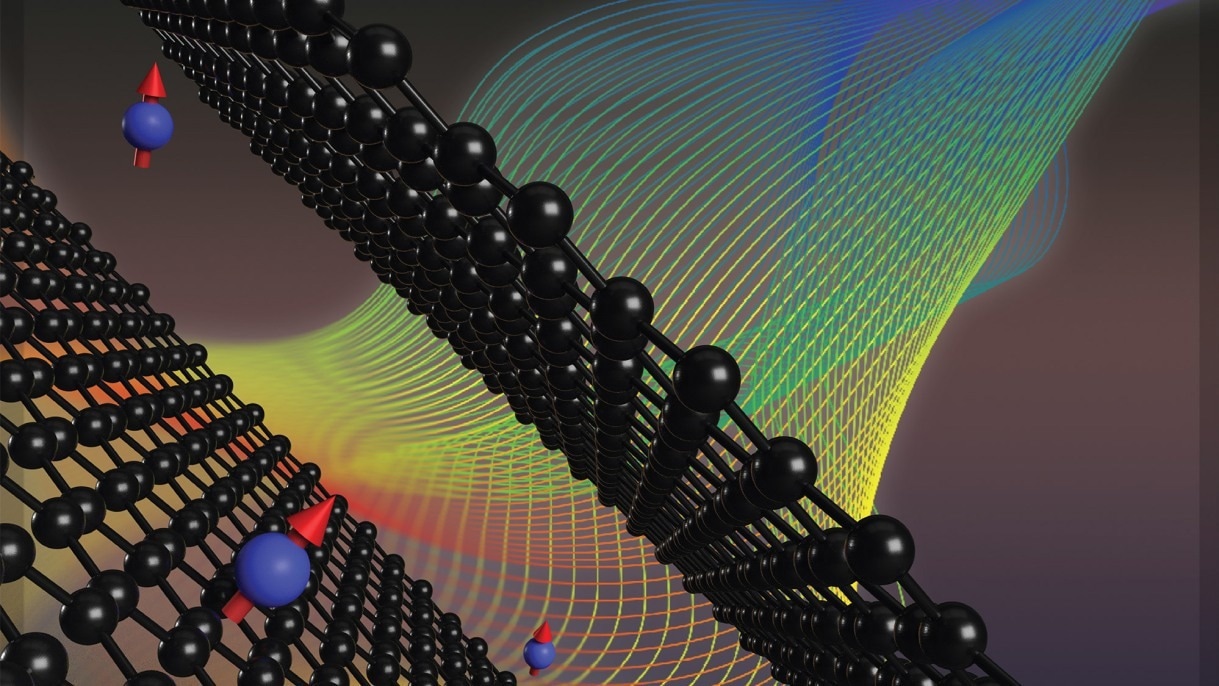A group of researchers headed by Brown University researchers discovered a solution for a long-standing roadblock in the field of two-dimensional electronics by analyzing spin structure in “magic-angle” graphene.

In the study, researchers describe what they believe to be the first measurement showing a direct interaction between electrons spinning in a 2D material and photons coming from microwave radiation. Image Credit: Graphic by Jia Li, an Assistant Professor of Physics at Brown
For the past two decades, physicists have attempted to alter the spin of electrons in 2D materials such as graphene. This could lead to significant breakthroughs in the developing field of 2D electronics, which uses super-fast, tiny, and flexible electronic devices to perform quantum-mechanical computations.
The conventional method for measuring the spin of electrons—an important feature that gives everything in the physical universe its structure—frequently does not function in 2D materials. This makes it extremely difficult to completely comprehend the materials and create technical advances based on them.
However, a group of scientists headed by Brown University researchers believes they have found a solution to this long-standing problem. In new research published in Nature Physics, they detail their solution.
The group, which also comprises scientists from Sandia National Laboratories and the University of Innsbruck, describes what they believe to be the first measurement of direct interaction between electrons spinning in a 2D material and photons emitted by microwave radiation in the paper.
The absorption of microwave photons by electrons, known as coupling, sets up an innovative experimental technique for effectively studying the properties of how electrons spin in these 2D quantum materials—one that, according to the investigators, could form the basis for developing computational and communicational technologies based on those materials.
Spin structure is the most important part of a quantum phenomenon, but we’ve never really had a direct probe for it in these 2D materials. That challenge has prevented us from theoretically studying spin in these fascinating material for the last two decades. We can now use this method to study a lot of different systems that we could not study before.
Jia Li, Study Senior Author and Assistant Professor, Brown University
The observations were performed on a relatively new 2D material known as "magic-angle" twisted bilayer graphene. This graphene-based material is formed by stacking two sheets of ultrathin layers of carbon and twisting them at just the correct angle, resulting in a superconductor that enables electricity to flow without resistance or energy waste. Unearthed in 2018, the investigators concentrated on the material owing to its potential and mystery.
“A lot of the major questions that were posed in 2018 have still yet to be answered,” says Erin Morissette, a graduate student in Li’s laboratory at Brown who guided the work.
Nuclear magnetic resonance, or NMR, is commonly used by physicists to determine the spin of electrons. They do this by employing microwave radiation to excite the nuclear magnetic characteristics of a sample material and then reading the distinct signals caused by the radiation to calculate spin.
The problem with 2D materials is that the magnetic signature of electrons as a result of microwave excitation is too tiny to detect. The study team decided to improvise.
Instead of directly sensing electron magnetization, they assessed small variations in electronic resistance induced by changes in magnetization produced by radiation using a device built at Brown’s Institute for Molecular and Nanoscale Innovation. Because of the slight fluctuations in the flow of the electronic currents, the researchers were able to utilize the device to identify that electrons were absorbing photos from microwave radiation.
The experiments provided the researchers with new information. For example, the team discovered that interactions between photons and electrons caused electrons in certain sections of the system to start behaving as they would in an anti-ferromagnetic system—that is, the magnetism of some atoms was canceled out by a set of magnetic atoms aligned in the opposite direction.
The new technique for investigating spin in 2D materials and the current discoveries are not useful to technology today, but the research team envisions future applications for the method. They intend to continue using this technology on twisted bilayer graphene while also expanding it to additional 2D materials.
“It's a really diverse toolset that we can use to access an important part of the electronic order in these strongly correlated systems and in general to understand how electrons can behave in 2D materials,” Morissette states.
The study was funded by the National Science Foundation, the US Department of Defense, and the US Department of Energy’s Office of Science.
Journal Reference
Morissette, E., et al. (2023). Dirac revivals drive a resonance response in twisted bilayer graphene. Nature Physics. doi.org/10.1038/s41567-023-02060-0.